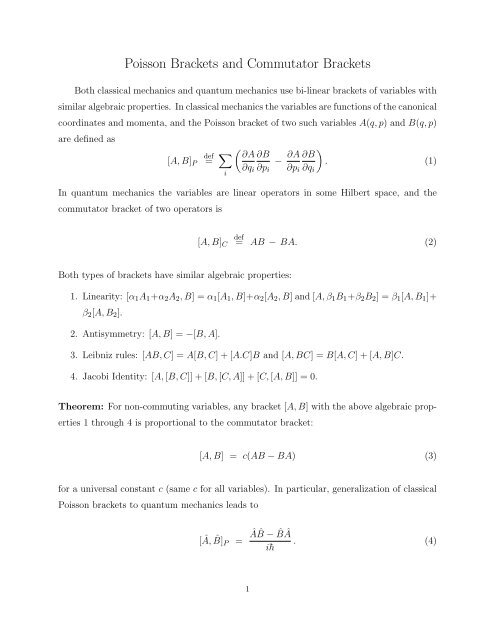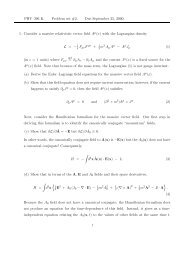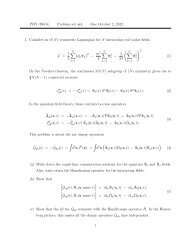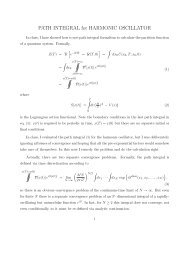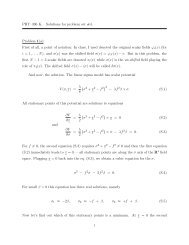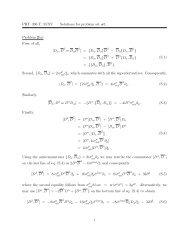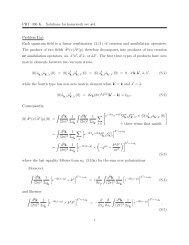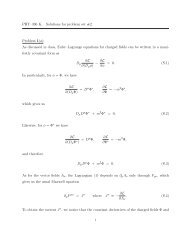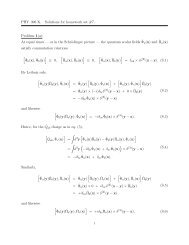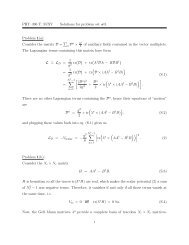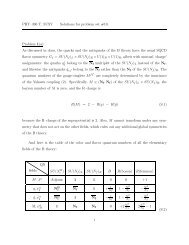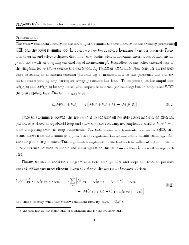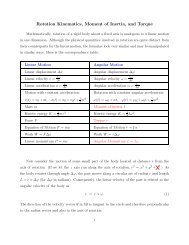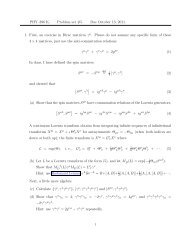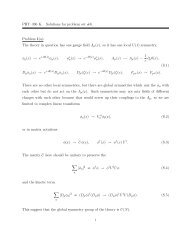Poisson Brackets and Commutator Brackets - The University of ...
Poisson Brackets and Commutator Brackets - The University of ...
Poisson Brackets and Commutator Brackets - The University of ...
You also want an ePaper? Increase the reach of your titles
YUMPU automatically turns print PDFs into web optimized ePapers that Google loves.
<strong>Poisson</strong> <strong>Brackets</strong> <strong>and</strong> <strong>Commutator</strong> <strong>Brackets</strong>Both classical mechanics <strong>and</strong> quantum mechanics use bi-linear brackets <strong>of</strong> variables withsimilar algebraic properties. In classical mechanics the variables are functions <strong>of</strong> the canonicalcoordinates <strong>and</strong> momenta, <strong>and</strong> the <strong>Poisson</strong> bracket <strong>of</strong> two such variables A(q, p) <strong>and</strong> B(q, p)are defined as[A, B] Pdef= ∑ i( ∂A ∂B− ∂A )∂B. (1)∂q i ∂p i ∂p i ∂q iIn quantum mechanics the variables are linear operators in some Hilbert space, <strong>and</strong> thecommutator bracket <strong>of</strong> two operators is[A, B] Cdef= AB − BA. (2)Both types <strong>of</strong> brackets have similar algebraic properties:1. Linearity: [α 1 A 1 +α 2 A 2 , B] = α 1 [A 1 , B]+α 2 [A 2 , B] <strong>and</strong> [A, β 1 B 1 +β 2 B 2 ] = β 1 [A, B 1 ]+β 2 [A, B 2 ].2. Antisymmetry: [A, B] = −[B, A].3. Leibniz rules: [AB, C] = A[B, C] + [A.C]B <strong>and</strong> [A, BC] = B[A, C] + [A, B]C.4. Jacobi Identity: [A, [B, C]] + [B, [C, A]] + [C, [A, B]] = 0.<strong>The</strong>orem: For non-commuting variables, any bracket [A, B] with the above algebraic properties1 through 4 is proportional to the commutator bracket:[A, B] = c(AB − BA) (3)for a universal constant c (same c for all variables). In particular, generalization <strong>of</strong> classical<strong>Poisson</strong> brackets to quantum mechanics leads to[Â, ˆB] P = Â ˆB − ˆBÂi¯h. (4)1
Pro<strong>of</strong>: Take any 4 variables A, B, U, V <strong>and</strong> calculate [AU, BV ] using the Leibniz rules, firstfor the AU <strong>and</strong> then for the BV :[AU, BV ] = A[U, BV ] + [A, BV ]U= AB[U, V ] + A[U, B]V + B[A, V ]U + [A, B]V U.(5)OOH, if we use the two Leibniz rules in the opposite order we get a different expression[AU, BV ] = B[AU, V ] + [AU, B]V= BA[U, V ] + B[A, V ]U + A[U, B]V + [A, B]UV.(6)To make sure the two expressions are equal to each other we needAB[U, V ] + [A, B]V U = BA[U, V ] + [A, B]UV‖⇓(AB − BA)[U, V ] = [A, B](UV − V U)‖⇓(7)[U, V ](UV − V U) −1 = (AB − BA) −1 [A, B]On the last line here, the LHS depends only on the U <strong>and</strong> V while the RHS depends onlyon the A <strong>and</strong> B, <strong>and</strong> the only way a relation like that can work for any unrelated variablesis if the ratios on both sides <strong>of</strong> equations are equal to the same universal constant c, thus[A, B] = c(AB − BA) <strong>and</strong> [U, V ] = c(UV − V U). (8)Quod erat demonstr<strong>and</strong>um.2


